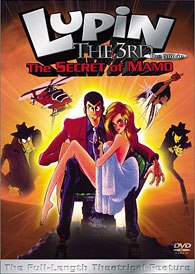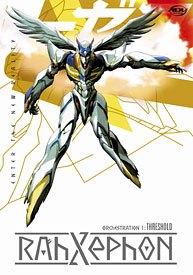Rick DeMott cracks open the box and journeys to the wealth of options provided by the new storyboarding software, FrameForge3D.
Around 1995, Japanese animation (anime) began pouring into North America, Europe and across the globe in video form. Most of these titles were unknown outside of Japan and never covered by animation journals. Whether a title is highly popular or very obscure, a high-quality theatrical feature or a cheap and unimaginative direct-to-video release, they all look the same on a store shelf. Therefore, Animation World Magazine will regularly review several new releases (including re-releases not previously covered) that have merit.

Alien Nine's producers ran out of money after the fourth episode. Real fans will have to read the manga for the rest of the story.
Alien Nine
OAV series, 2001. Director: Jiro Fujimoto. 100 minutes. Price & format: DVD bilingual $29.99. Distributor: Central Park Media/U.S. Manga Corps.
Some anime is mysterious and confusing in a good way. Alien Nine starts off fine, but it is frustratingly incomplete unless you are willing to read the cartoon-art novel to continue the story.
In the near future (2013 if you add the dates up), attacks by alien feral animals on Earth's elementary schools have become such a routine occurrence that students are assigned to capture them as a school chore, like taking out the trash. This is not considered dangerous because the children are issued intelligent alien "'borg" symbiotic partners to protect them. The borgs, which look like giant talking frog heads or lizard heads, perch on their heads and live on their hosts' body wastes.
At No. 9 Elementary School, the alien fighters are one girl from each of the three sixth grade classes. 11-year-old Kasumi and Kumi are volunteers who think it is cool to get excused from classes to race around the school on roller blades with tranquilizer guns chasing creatures that range from mouse-size to horse-size (many drawn as recognizable "tributes" to famous literary sci-fi aliens, such as the Pierson's Puppeteers from Larry Niven's stories), with their symbiotic partners as an eye-catching uniform. Their third partner, Yuri Otani, is their total opposite; a girl who considers all aliens yucky, who is humiliated by having to go around in public with a giant slobbery frog sitting on her head, and is disgusted by having to take it into the bathroom to eat her wastes. She was stuck with the job because none of her classmates would take it.
Yuri equates all aliens with the deadly chest-bursting monster from the old movie, especially since those she is assigned to catch usually look like giant spiders and centipedes. She is usually so scared that she either faints or her terror triggers her borg into overreacting and killing the alien instead of capturing it. Although it is obvious to all that Yuri is totally unsuited to the post, the school's cheerful Alien Party Advisor Ms. Hisakawa refuses to release her.
Alien Nine starts out as wacky humor, nicely mixing the bizarre and mildly gross-out situations that 11-year-olds like with a cryptic, but apparently well-planned sci-fi plot. It is a bit annoying that the protagonist is such a crybaby that you want to slap her, although it gradually looks like she may have a justification to be. Are the aliens really "picking on" Yuri more than on the others? Is Ms. Hisakawa, who is less human than she originally seemed, targeting Yuri for "special attention" -- and if so, for benign or malevolent reasons? Do comments about the children "getting used" to their symbiotic partners have a sinister biological double-meaning?
Unfortunately, as is revealed in the DVD's extras, this anime project ran out of money after the fourth 25-minute episode. Alien Nine was produced by the new GENCO company, with animation by the J.C. Staff studio, and released as four OAVs on 6/25/01, 9/25/01, 11/25/01 and 2/25/02. (The original Japanese trailers are also among the DVD extras.) GENCO founder and exec producer Taro Maki, in a video interview, admits that the ending is "ambiguous" and that he hopes to raise funding to continue the anime.
Meanwhile, a commercial blurbed, "The story has just begun!" advises you to buy CPM's English-language edition of author Hitoshi Tomizawa's original Alien Nine manga to find out what happens next. There are many anime direct-to-video productions that break off in mid-story; Alien Nine is more forthright than most in admitting what has happened. If the American release is popular enough, maybe production can afford to resume.

In .hack//SIGN, Wavemaster is caught in The World, a role-playing game site and cant get back to the real world.
.hack//SIGN. V.1, Logon. V.2, Outcast. V.3, Gestalt. V.4, Omnipotence. V.5, Uncovered. V.6, Terminus.
TV series (26 episodes), 2002. Director: Koichi Mashimo. V.1-2, five episodes/125 minutes, v.3-6, four episodes/100 minutes. Price & format: DVD bilingual $29.98. Distributor: Bandai Entertainment.
There is no doubt that hack//SIGN is one of the most popular anime titles of the moment, just judging by the number of fans attending 2003 anime conventions in costume as hack//SIGN characters. It was a cult hit in Japan (26 TV episodes broadcast from April 4 through September 26, 2002), and with anime fans in America on The Cartoon Network from February 1 through August 30, 2003.
It is actually just one component in a successful mass-merchandising project by entertainment media giant Bandai Visual. In a fictional near-future, the Internet is controlled by the CyberConnect Corp. CC has created a hugely popular online fantasy role-playing site called "The World," where people can log in to become warriors, knights, thieves and other sword-&-sorcery characters to go on solo adventures or band together for group quests. Players around the world transport themselves into The World for a few hours of fantasy fun. But rumors start that a tiny number of players are found in comas at their computer keyboards. Have their consciousnesses become trapped in The World?
Bandai has developed this .hack (pronounced dot-hack) scenario in an actual videogame, a text novel, a manga novel (which has since been animated as a 12-episode TV series, .hack//LEGEND OF THE TWILIGHT BRACELET), an anime TV series, and an anime four-episode OAV series (.hack//LIMINALITY), each of which reveal new aspects of the mystery. This review is concerned with the .hack//SIGN anime TV series.
hack//SIGN can serve as a showcase of most of the assets of Japanese TV-style animation. The actual animation (by the Bee Train studio) is limited, but the fantasy settings (the background paintings) are stunningly beautiful, the character designs by top designer Yoshiyuki Sadamoto are appealing and imaginatively original (thanks to the fantasy-world costuming), and the music by Yuki Kajiura has caused the anime's soundtrack CD to become a constant sell-out at anime specialty shops.
The story takes place inside The World, with only brief black-and-white flashes to hint at what is happening simultaneously to the players in the real world. A strange young Wavemaster (mage), Tsukasa, appears who acts in a manner supposedly impossible by the nature of The World. He cannot remember his identity outside the game, and he cannot log out and return to the real world. Some players consider him a threat to the gameplaying rules; some view him as a victim and wonder who or what is manipulating him; and some try to take advantage of his special abilities. Some are sympathetic and try to help him.
.hack//SIGN is really their story: of the friendship that develops among Mimiru, Bear, Subaru, Crim and Tsukasa, of what they learn about each other, and the real nature of the electronic fantasy world which they are in. This is another attribute of good TV anime: not much action, but intelligent and intriguing dialogue that will make you anxious to find out what will be revealed next, rather than dismissing it as only a lot of boring talking heads.

A German schnauzer is about to grant a confused girl three wishes that lead to surprising results in Junkers Come Here.
Junkers Come Here.Theatrical feature, 1995. Director: Junichi Sato. 105 minutes. Price & format: DVD bilingual $29.98. Distributor: Bandai Entertainment.
This charming award-winner and laureate of the Japanese Board of Education puts a fantasy gloss on a serious problem faced by many modern affluent youth. 11-year-old Hitomi Nozawa apparently has no worries. She has lots of school friends, and her workaholic parents provide her with a lovely home. Her mother is a busy executive for an international hotel chain who seldom gets home before midnight, while her father is a commercial photographer who is constantly on assignments around the world.
Hitomi knows that they love her, even if she sees less of them than of Fumie, their friendly though scatterbrained housekeeper, and Keisuke, a college student who is her live-in tutor (whom she has a crush on). Her best friend of all is Junkers, her pet German schnauzer, who can talk -- but only to her.
Then it starts to fall apart. Her parents, who have been drifting apart due to their separate jobs, decide to do "the sensible thing" and have a friendly divorce. Her mother has just been appointed manager of her chain's newest luxury hotel in San Francisco, and she will take Hitomi with her. They are sure that Hitomi, who is so logical and intelligent, will realize that this is best for her. Hitomi learns that she could not keep her Japanese home life even if she chooses to stay with her father, because the reliable Keisuke is about to graduate from college, marry his fiancee and leave to begin his own career; and Fumie is too unreliable to be a guardian by herself.
Then Junkers reveals that he can do more than talk; he can grant three wishes. Hitomi finds her intellect and rational logic is in conflict with her 11-year-old emotions. Is it fair to use magic to force her parents and Keisuke to adjust their lives to her convenience? -- especially when a tentative attempt to wish that Keisuke will not leave turns out to have unexpectedly unpleasant consequences.
Junkers Come Here, based on a young-adult novel by Naoto Kine (who composed the movie's music and provides the voice of the father), was animated by the Triangle Staff studio and released on March 18, 1995. Everything is developed in such a low key that it could be called pedestrian, although it is clear that this is deliberate. The art style is nicely realistic, painted in pastel watercolors. Kine's music is pleasantly adequate, but unmemorable. The dialogue is what you might expect from listening to an imaginative 11-year-old.
The emphasis is on the human-interest problem. What stands out are the warm relationship between Hitomi and Junkers (the dog has an engagingly quirky personality, including using a toilet in a human manner when nobody is looking), and the conflict between logic and emotion that even the most intelligent child would face in such a situation. In some respects Hitomi's intelligence makes her suffer even more. It gradually becomes clear that all her schoolmates are juvenile and shallow; Junkers is the only "person" she can relate to as an equal. (If it were not for a couple of gag situations such as a school crossing guard overhearing Junkers talking, the audience could wonder whether Hitomi's loneliness has caused her to imagine Junkers' human intelligence and speech.)
Hitomi is torn between pride that her parents respect her intelligence, and resentment that they do not really show any understanding of her own feelings; and between her realization that Keisuke and her parents have their own lives and goals, and any child's emotional reluctance to "leave the nest." Junkers Come Here is an excellent film for children who are about to experience the emotional trauma of growing up, whether their home lives are secure or not.

Lupin the 3rd: The Movie -- The Secret of Mamo parodies Spielberg, Stranglove and Clinton.
Lupin the 3rd: The Movie -- The Secret of Mamo.Theatrical feature, 1978. Director: Soji Yoshikawa. 100 minutes. Price & format: DVD bilingual $24.98. Distributor: Pioneer Entertainment.
Cartoonist Monkey Punch's Lupin III has been filtering into America since before anime began to be commercially licensed. There was a 1971-1972 23-episode anime TV series by the Tokyo Movie Shinsha (now TMS Entertainment) animation studio that was moderately popular; then a 1977-1980 155-episode series that was so popular that it spun off two theatrical features; this one, Lupin III, released December 16, 1978, and Lupin III: The Castle of Cagliostro (Hayao Miyazaki's theatrical feature directorial debut), released December 15, 1979. (The list of TMS' Lupin III TV and theatrical anime credits from then to date would fill a page.) The Castle of Cagliostro is generally considered a better feature, but The Secret of Mamo (to use this DVD release's title) is still plenty of fun and is more faithful to Lupin's TV persona.
Lupin III is the modern descendant of early 20th century fictional gentleman-thief Arsene Lupin; a suave, jet set international master thief usually accompanied by partners Jigen (a Chicago-gangster type) and Goemon (a traditional Japanese samurai), and pursued by Interpol Inspector Zenigata. Also present is femme fatale Fujiko, though one never knows whether she will be Lupin's ally or his rival.
For this first Lupin III theatrical feature, the whole cast was pitted against Mamo, a mysterious French megalomaniac who tried to use Lupin as a dupe in a scheme to seize control of the U.S.' and the Soviet Union's nuclear weaponry. The story is fast and funny, with constant unexpected plot twists that melded many parodies of scenes from 1960s and 70s TV and movie thrillers from Spielberg's debut Duel to Dr. Strangelove into a coherent original and suspenseful thriller. The superb jazz score by Yuji Ohno also deserves a mention.
TMS had it immediately dubbed into English for a JAL trans-Pacific in-flight movie. Barely-legible bootleg videos of that dub were popular among anime fans until a new commercial dub was released on video in 1995 as Lupin III: The Mystery of Mamo. This Pioneer release is a third English dub. Since the plot involves a terrorist nuclear threat, it is amusing that the three dubs include references to world events in 1978, 1995 and 2003, with parodies of the voices of presidents Jimmy Carter, Bill Clinton and George W. Bush.
Pioneer's DVD includes the original Japanese soundtrack with a subtitled translation which was not previously available, in addition to its new English dub which is less faithful than the previous two. (Granted the dialogue is full of witty repartee, Inspector Zenigata's lines now unfortunately sound more like inane one-line jokes than reasonable conversation. This lessens the cleverness of Lupin's escapes, since it does not take any great intelligence to outwit an adversary who sounds like a boob.) The DVD extras include a translation of the original 1978 12-page souvenir press book.
In the 1980s, when TMS began turning out Lupin III movies in quantity, the studio retroactively retitled this one Lupin vs. the Clone. If you hear of that title and wonder if that is a different movie, no it is not.

RahXephon delivers the goods, especially in the areas of characters, costumes and mecha designs.
RahXephon. V.1, Threshold V.2, Tonal Pattern. V.3, Harmonic Convergence. V.4, Dissonance. V.5, Synaesthesia. V.6, Aria. V.7, Crescendo.
TV series (26 episodes), 2002. Director: Yutaka Izubuchi. V.1, five episodes/125 minutes; v.2, 4 & 6, four episodes/100 minutes; v.3, 5 & 7, three episodes/75 minutes. Price & format: DVD bilingual $29.98. Distributor: A.D.V. Films.
The publicity for RahXephon ("This century's first high density sci-fi animation," "Finally, a mecha anime for the 21st century!") implies something special. In general, it delivers. RahXephon was the first major TV anime series created by the new BONES, Inc. animation studio (founded in October 1998 by veterans from the Sunrise studio), and they went all out to make it stand out with especially attractive character, costume and mecha designs. The solipsistic sci-fi plot of an average guy finding out that he is not average, and actually the whole world is a sham constructed around him, is nothing new (from the Japanese Megazone 23 to the American The Matrix). Creator/director Yutaka Izubuchi stated in interviews that he took a lot of old sci-fi anime stereotypes and updated them to a modern, more sophisticated artistic and plot level.
Ayato Kamina is apparently a normal high school student. Suddenly Tokyo is attacked by mystery fighter planes, and Japan's Self-Defense Force defends with incredible flying giant stylized statues of singing women named Allegretto and Fortissimo who shatter the attacking planes with sonic waves. Ominous "men in black" government agents try to hustle Ayato off at gunpoint, but he is saved from them by an ass-kicking female secret-agent type while one of his classmates, a girl whose beauty is so ethereal that it is a good bet she is not human, leads him to an unmarked subway stop that looks like a cross between a military base and an Aztec shrine, where... (and this is in just the first episode).
After this attention-grabbing pilot episode, an introspective mood soon predominates. Ayato learns that Tokyo was conquered by aliens called Mulians 15 years earlier, and enclosed in a force-field dome cutting it off from the rest of the world. The Mulians use mind control on the inhabitants to Tokyo to keep them from realizing what is going on. Ayato is soon helped to escape from Tokyo, and he joins the Earth Federation's TERRA defense force which seeks to learn more about the aliens to combat them effectively. Several episodes are spent introducing a supporting cast and building up their varied personalities.
Yet Ayato is quickly aware that he is not being told everything. Part of the secrecy appears due to petty factional backstabbing among the international agencies fighting the aliens, but some of his new acquaintances also seem to have secret personal reasons to help or hinder him. The more paranoid Ayato becomes and investigates what is being hidden from him, the more reasons he learns everyone has to distrust him. Is his mother the leader of the Mulians? Who are the Mulians, really? Who is actually behind the Earth Federation?
RahXephon was a 26-episode TV series, broadcast on Fuji TV weekly (with several breaks) from January 21 through September 11, 2002 on Tuesdays at 1:58 am (?!). Despite the ungodly timeslot, it was popular enough to be condensed into a theatrical feature with about 20 minutes of new animation (released April 19, 2003) and made into a video game. The action is not as important as the mature emotional depth of the characters and their relationships (episode 18 is a particularly somber shocker), and the complex sci-fi scenario involving different time-rates (times passes more slowly in Mulian-controlled Tokyo) and the uses of song and music as a sonic weapon (the 26 episodes are called First Movement, Second Movement, etc.).
Fred Patten has written on anime for fan and professional magazines since the late 1970s. He wrote the liner notes for Rhino Entertainment's The Best of Anime music CD (1998), and was a contributor to The World Encyclopedia of Cartoons, 2nd Edition, ed. by Maurice Horn (1999) and Animation in Asia and the Pacific, ed. by John A. Lent (2001).







